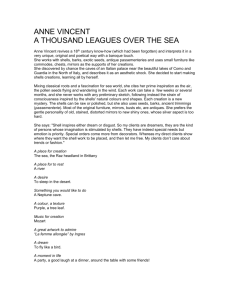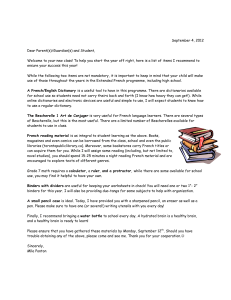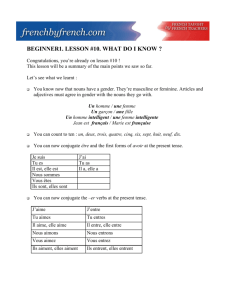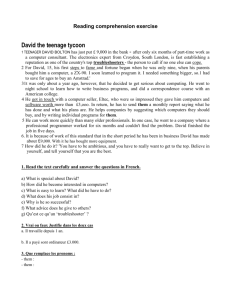Conversations about collaboration in response to “Foreign
advertisement
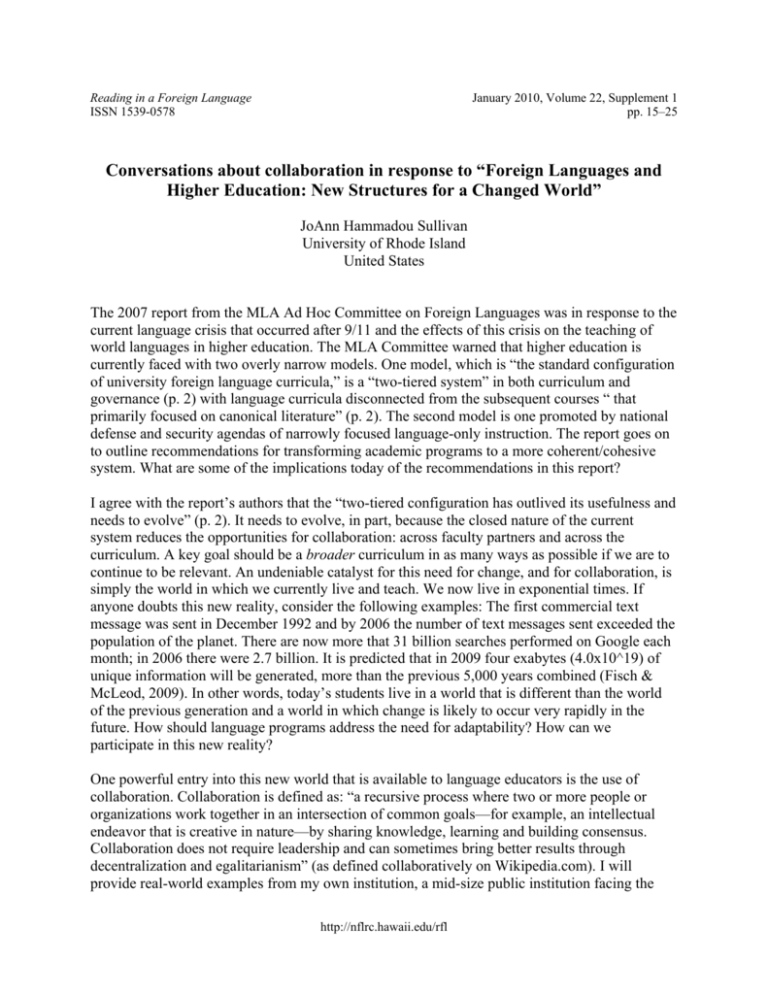
Reading in a Foreign Language ISSN 1539-0578 January 2010, Volume 22, Supplement 1 pp. 15–25 Conversations about collaboration in response to “Foreign Languages and Higher Education: New Structures for a Changed World” JoAnn Hammadou Sullivan University of Rhode Island United States The 2007 report from the MLA Ad Hoc Committee on Foreign Languages was in response to the current language crisis that occurred after 9/11 and the effects of this crisis on the teaching of world languages in higher education. The MLA Committee warned that higher education is currently faced with two overly narrow models. One model, which is “the standard configuration of university foreign language curricula,” is a “two-tiered system” in both curriculum and governance (p. 2) with language curricula disconnected from the subsequent courses “ that primarily focused on canonical literature” (p. 2). The second model is one promoted by national defense and security agendas of narrowly focused language-only instruction. The report goes on to outline recommendations for transforming academic programs to a more coherent/cohesive system. What are some of the implications today of the recommendations in this report? I agree with the report’s authors that the “two-tiered configuration has outlived its usefulness and needs to evolve” (p. 2). It needs to evolve, in part, because the closed nature of the current system reduces the opportunities for collaboration: across faculty partners and across the curriculum. A key goal should be a broader curriculum in as many ways as possible if we are to continue to be relevant. An undeniable catalyst for this need for change, and for collaboration, is simply the world in which we currently live and teach. We now live in exponential times. If anyone doubts this new reality, consider the following examples: The first commercial text message was sent in December 1992 and by 2006 the number of text messages sent exceeded the population of the planet. There are now more that 31 billion searches performed on Google each month; in 2006 there were 2.7 billion. It is predicted that in 2009 four exabytes (4.0x10^19) of unique information will be generated, more than the previous 5,000 years combined (Fisch & McLeod, 2009). In other words, today’s students live in a world that is different than the world of the previous generation and a world in which change is likely to occur very rapidly in the future. How should language programs address the need for adaptability? How can we participate in this new reality? One powerful entry into this new world that is available to language educators is the use of collaboration. Collaboration is defined as: “a recursive process where two or more people or organizations work together in an intersection of common goals—for example, an intellectual endeavor that is creative in nature—by sharing knowledge, learning and building consensus. Collaboration does not require leadership and can sometimes bring better results through decentralization and egalitarianism” (as defined collaboratively on Wikipedia.com). I will provide real-world examples from my own institution, a mid-size public institution facing the http://nflrc.hawaii.edu/rfl Hammdou Sullivan: Conversations about collaboration 16 economic hardships that many schools face in these difficult times, in order to show that there are a wide range of steps that any faculty can implement to facilitate and benefit from collaborations, intellectual endeavors that are creative in nature. Faculty and students can collaborate in multiple ways. I will look at broad-based curricular and governance collaborations that extend beyond joint peer assignments in an individual class. Faculty Collaborations One fruitful area of collaboration will be the growth of interdisciplinary work among higher education colleagues. The MLA report refers to “alliances with other departments and expressed through interdisciplinary courses” (p. 3). Many higher education faculty are currently doing just such a thing. I propose there needs to be more such collaboration in order to maximize intellectual endeavors that are creative in nature by sharing knowledge, learning and building consensus. I offer three varied examples of collaboration from my own Department of Modern and Classical Languages and Literatures at the University of Rhode Island. In open-ended interviews, the collaborators address the motivations and the benefits of such work to the programs, to the faculty at varying stages of their careers and, most importantly, to students. In the first example, French professor, Karen deBruin, has created an interdisciplinary course, “The Power of the Word: Prison in the Arts and the Arts in Prisons”, with collaborator Rev. Sharon Key who is Director of Interfaith Community Outreach of the Rhode Island Center for Nonviolence and Peace Studies (and former prison chaplain). Their course has college students and prisoners in maximum security (some serving life sentences) reading the same literature, sharing writing and discussing, in prison, the points of intersections of their understanding of the literature. The primary focus is how we are all prisoners to some degree and how even a prisoner who has little chance of leaving prison gives meaning to life. For her students Dr. deBruin hopes that “if asked what is the purpose of literature and philosophy, after this course, I hope [they] will answer, without even thinking about it, ‘to give meaning to your life’” (personal communication, July 2, 2009). For Rev. Key’s part, she always asks maximum-security inmates, “How can the world remember you other than you did something horrible?” Her goal for the university students is that they “will see that these are human beings too, highly intelligent with a whole lot to offer” (personal communication, July 19, 2009). Rev. Key in discussing personal benefits says, “I’m a teacher at heart. That’s when I’m happiest. I love this chance to work in academia.” The two collaborators hope to broaden the collaboration to include other writers currently in prison and to extend the university’s offerings to those in state prison. This course was “designed with a motivation to keep the humanities from being pushed into a box . . . seeking connection and relevance to today’s world and the need to connect literature to the striving for social justice” (K. de Bruin, personal communication, July 2, 2009). In the second example, German professor, John Grandin, director of the University’s International Engineering Program (IEP), describes the start of the program that he helped found in 1987 in which students earn a dual degree in an engineering field plus German, French, or Spanish. This collaboration is the oldest, largest and most established collaboration of the three Reading in a Foreign Language 22(Supplement1) Hammdou Sullivan: Conversations about collaboration 17 examples here. In a recent interview Dr. Grandin explains: From the point of view of a German professor, in that time, 22 years ago, I could see that we were basically going down the tubes. Enrollment was declining. If we didn’t do something different we could lose the German major all together. When a new dean of engineering arrived with a German name who could see the growing trend of globalization, we put our heads together, formed a committee and created this five year program with a fourth year abroad for the double major. With the help of a grant, we were able to get things up and running pretty fast. For a collaboration to be successful, there needs to be a mutual benefit. In languages we saw a benefit to create more language majors, the engineer saw the opportunity to create an innovative program to prepare his students internationally. It’s been a win/win situation ever since. We’ve attracted hundreds of students to languages to complete a full degree in a language that, otherwise, would have taken no language courses at all. Collaboration has been a long, slow process. But we both had a passion for the idea. There were doubters in the beginning, but as it started to work, more and more people wanted to help out (personal communication, July 14, 2009). The final example is still in its formative stages. Engineering faculty and two language professors from Spanish and German are currently creating a general education course entitled “Introduction to Global Environmental Sustainability and Green Engineering.” This course will consist of lecture-style engineering coursework with three pull-out discussion groups, one each in Spanish, German and English. The catalyst for the course was the need for courses specific to the Spanish International Engineering Program’s needs (see above). With collaboration among Engineering faculty, Spanish professor, Megan Echevarria, and German professor, Damon Rarick, the new course is in the planning stage. Dr. Echevarria, Director of the Spanish International Engineering Program, states: I wanted to create a course that would get Spanish IEP students thinking and speaking about engineering in Spanish. I really like collaboration and I like the idea of going beyond the boundaries of pure literary studies myself. I am dealing with an area much further from my own area than I’ve ever dealt with before…I like the challenge of reaching beyond my usual comfort zone . . . . (personal communication, July 20, 2009). There are also two larger goals that they hope to achieve beyond the obvious one of creating an opportunity for students to improve their Spanish or German while learning interesting new content. We want to create opportunities for students from across the entire university, regardless of their background in science or math, to learn about environmental sustainability and basic engineering concepts. The idea is to eliminate (or at least reduce) the fear the technical disciplines sometimes inspire in students. We also would like to give our engineering students the chance to reflect on their own technical areas from a more balanced, interdisciplinary and international perspective. We are trying to enrich the engineering curriculum through this contact with the humanities and the social sciences (M. Echevarria, personal communication, July 27, 2009). Reading in a Foreign Language 22(Supplement1) Hammdou Sullivan: Conversations about collaboration 18 They chose to have the discussion groups led by international graduate exchange students in engineering who are native speakers of Spanish or German. Dr. Rarick states: It’s always exciting to work with dynamic colleagues. But also, these graduate students are technically some of the world’s very best. I learn so much from them each time I work with them“ (personal communication, July 20, 2009). Dr. Echevarria adds: “The primary reason that we wanted to do it is to give the IEP students early access to meaningful interaction with engineering students from other countries. That is also why we plan to include videoconferences with students from our partner institutions abroad as part of the foreign language discussion sections” (personal communication, July 27, 2009). She explains that by training the international graduate students in engineering to lead the discussion sections they also overcome the obstacle of being currently short-handed in tenure-track Spanish faculty. Both remark that they hope to encourage engineers and non-engineers to take a proactive role in minimizing environmental problems. Two common arguments emerged in all of the interviews. First, the recognition and identification of “mutual benefit” is a common theme across all three successful collaborations. These mutual benefits involve both professional growth for the collaborating faculty and learning opportunities for a broad spectrum of students. Secondly, all expressed an excitement for the project’s goals. Most faculty used the word “passion” at some point in describing their involvement. Within one relatively small state university language department, multiple successful models are evident. This fact points to the benefit of institutional flexibility to allow and, hopefully, promote and reward these creative activities. Language Learner Collaborations The MLA report states: “The language major should be structured to produce a specific outcome: educated speakers who have deep translingual and transcultural competence” (p. 2). Terms such as “transcultural competence” or similarly “global competence” (e.g., Hunter, White, and Godbey, 2006; Lambert, 1996) or “intercultural competence” (Grandin & Hedderich, 2009) overlap and are notoriously difficult to define. One definition of transcultural competence is “part of a broad foreign speaker competence . . . the ability of a person to behave adequately and in a flexible manner when confronted with actions, attitudes and expectations of representatives of foreign cultures” (Meyer, 1991). A second definition offered is the “ability that provides a clear framework for leading effectively and ethically across cultural boundaries, identifying hidden obstacles and enabling diverse people to accomplish common goals” (Boas, 2006). Professional fields, such as engineering, are giving increasing attention to these concepts (Grandin & Hedderich, 2009). Hunter, White, and Godbey (2006) conducted a survey and three rounds of debate with a panel of 17 experts from education, international business, the United Nations and foreign government officers to conclude that global competence is “having an open mind while actively seeking to understand cultural norms and expectations of others, leveraging this gained knowledge to interact, communicate and work effectively outside one’s environment” (p. 277). How do foreign language departments in higher education play a role in promoting such lofty goals? Reading in a Foreign Language 22(Supplement1) Hammdou Sullivan: Conversations about collaboration 19 I propose that one powerful tool for reaching this desired outcome is collaborative work within a native culture of a language studied. Whether those experiences come from within the borders of the United States, via electronic technologies, or by foreign travel, an additional step toward this goal is for learners to write their personal responses to their transcultural experiences and share these responses with their language learner peers. Language learners benefit from having such experiences, writing about them and reading about similar experiences of their peers. In having these experiences the language learner gains awareness of the target work culture as a collaborative enterprise. In writing about such experiences they gain the additional consciousness that the process of reflection and composition produces. In reading about their peers’ experiences, they can see a target culture through the eyes of a peer whose native background and perspective is likely to be similar to their own thereby increasing their likelihood of gaining entry into the new culture. They can follow a peer who is growing and gaining confidence in his or her ability to “understand cultural norms and expectations of others, leveraging this gained knowledge to interact, communicate and work effectively outside one’s environment” (Hunter, White, & Godbey, 2006, p. 277). I will provide examples of the students’ own thoughts on these topics in a moment. The MLA Committee adds as an expectation: “In the course of acquiring functional language abilities, students are taught critical language awareness, interpretation and translation, historical and political consciousness, social sensibility, and aesthetic perception” (p. 3). All of the above characteristics are valuable life skills. Language study that includes work experience in the target culture(s) is one powerful way to promote these important skills. Lohmann, Rollins and Hoey (2006) propose that “international knowledge and experience should be integrated and relevant to a student’s field of study, i.e., global competence should include an understanding of the relevance of international cultures to a student’s major” (p. 121). In this way foreign language departments extend their reach throughout their student population. In five different French students’ own written words, what follows are specific student examples of the skills listed in the MLA Committee’s report gained in collaborative international work experiences abroad. Language Awareness The following French and Mechanical Engineering double major, Roman Alferos, discusses a key term related to his engineering internship in France with a company that studies industrial and environmental uses of gases: Lors de mon arrivée j’ai commencé mes études sur l’« adsorption ». Bien que mes connaissances sur le sujet ne soient pas encore très développées, j’arrive néanmoins aujourd’hui à en comprendre le fonctionnement. Avant mon départ des Etats-Unis, j’ai demandé à trois étudiants de chimie une définition précise de ce qu’était l’adsorption. Tous m’ont donné des réponses différentes et aucune d’entre elles ne me servent dans mon travail. Celles-ci sont reprises ci-dessous avec les corrections que je suis aujourd’hui en mesure d’y apporter . . . . Reading in a Foreign Language 22(Supplement1) Hammdou Sullivan: Conversations about collaboration 20 Since my arrival (in France) I have begun my studies on adsorption. Although my knowledge of the subject was not very well developed, nevertheless I can now understand how it works. Before leaving the United States, I asked three chemistry students for a precise definition of adsorption. They all gave me different answers and none of them helped me in my work. Each is revisited below with the corrections that I am now capable of providing . . . . (He then proceeds to give the definitions that were offered him by his American peers and the flaw in each.) The second example from another intern comes from the more mundane topic of explaining food differences at his work site to his fellow students at home: Jambon poulet—Ca m’a beaucoup confondu. Est-ce du porc ou du poulet? En fait, c’est du poulet tranché comme le jambon. Pas mal pour les sandwichs.1 Chicken ham—That really confused me. Is it pork or chicken? In fact, it’s chicken sliced like ham. Not bad for sandwiches. Historical consciousness C’est incroyable parce qu’ici, en France, une personne peut voir et vivre l’histoire. Je pense que la signification change quand vous êtes dans un endroit où les nazis ont pris les juifs. C’est un peu comme le film The Night at the Museum avec Ben Stiller. En France, c’est possible à vivre l’histoire juste comme dans le film mais bien sûr sans les petits gens. C’est cool comment ma vue de l’histoire change depuis que je suis arrivé en août.2 It’s incredible because here, in France, a person can see and live history. I think that the significance changes when you are in a place where the Nazis took the Jews. It’s a little like the film The Night at the Museum with Ben Stiller. In France, it’s possible to live history just like in the movie, but of course without the little people. It’s cool how my view of history is changing since I arrived in August. Political consciousness Tout a changé avec l’élection du Président Obama et j’en suis bien content. Mon « colloc » porte un t-shirt qui montre le visage d’Obama avec son célèbre « Hope ». En fait, personne ne blâme les Etats-Unis, mais plutôt son ancien président : Bush. Aujourd’hui, il n’y a plus autant de mauvaises blagues sur les Etats-Unis, mais plutôt un réel engouement pour Obama. J’espère que les Etats-Unis lui en sont reconnaissants.3 Everything changed with the election of President Obama and I’m happy about it. My [French] roommate wears a t-shirt that shows Obama’s face with his famous “Hope.” In fact, nobody blames the United States but rather our former president: Bush. Today, there Reading in a Foreign Language 22(Supplement1) Hammdou Sullivan: Conversations about collaboration 21 aren’t as many bad jokes about the United States, but rather a keen attraction to Obama. I hope that the United States is grateful to him. Social sensibility Student reports on this topic abound. Here is just one example among many. La France a une culture haute-contexte: tout le monde doit connaitre ses responsabilités. L’un de mes profs répétait toujours une expression préférée lorsqu’un étudiant lui demandait quelque chose: pour trouver le succès, il faut pousser les problèmes vers le bas, et les solutions vers le haut. En tant que stagiaire, naturellement, je suis en bas, donc, tout le monde me donne leurs problèmes. A la fois, [X] est une entreprise ouverte, alors, je suis allé en parler avec mon chef. Là, j’ai fait une grande erreur. Dans une entreprise française, quand on se rencontre pour la première fois dans la journée, on se dit bonjour et serre la main. On doit se souvenir si on l’a déjà fait, et ne pas offrir la main une deuxième fois. Cela, je le savais. Je ne me suis pas rendu compte que c’était la même chose avec le bonjour. Alors, quand j’ai dit bonjour à mon chef, la réponse était un murmure, « re-bonjour. »1 France is a culture of high context: everyone must know their responsibilities. One of my professors always repeated his favorite saying whenever a student asked him anything: to find success, you have to push the problems to the bottom and the solutions to the top. As an intern, naturally, I’m at the bottom, so, everyone gives me their problems. Still, [X] is an open company so I went to speak to my boss about it. There I made a big mistake. In a French company, when you meet somebody for the first time in the day, you say hello and shake hands. You have to remember if you already did it and don’t offer to shake a second time. That’s what I knew. I didn’t realize that it’s the same thing with the hello. So, when I said hello to my boss the answer was a muttered re-hello. Language interpretation The following example seems to straddle both social sensibility above (the interns’ favorite topic) and interpretation of language. Le problème avec ‘tu’ et ‘vous’ est familier pour tout Américain qui se trouve en France. La distinction entre les deux est tellement importante, mais il est souvent difficile de décider si une personne mérite d’être vouvoyée ou tutoyée. D’habitude, c’est l’âge qui compte. A l’université, il n’y a pas de souci: tout étudiant est ‘tu’ et tout prof est ‘vous.’ Au travail, par contre, ça devient flou. Moi, j’ai 22 ans maintenant. J’ai des collègues qui en ont 23, 25, 30 . . . pour être certain, je les vouvoyais tous, et j’attendais qu’ils me permettaient de faire le contraire. Cependant, c’est un peu plus nuancé que ça! Je travaille dans les TP (travaux publics), et, normalement, tout le monde se tutoie, même les chefs. Quand même, comme je ne veux Reading in a Foreign Language 22(Supplement1) Hammdou Sullivan: Conversations about collaboration 22 pas sembler impoli, j’utilise ‘vous,’ bien que tout le monde me tutoie. Même les secrétaires, qui me parlaient pendant dix minutes à propos de l’importance de ‘vous,’ admettent que tous les collègues les tutoient, et l’hypocrisie se voit: elles me tutoient, aussi. Et si ce n’était pas assez confondant, le notaire, qui est plus âgé et moins naïf que moi, m’appelle ‘vous.’ Alors, j’ai continué avec mon plan. Dans un premier temps, il était facile, car je vouvoyais chaque collègue, mais une fois par semaine, j’ai eu la permission de tutoyer quelqu’un. La semaine passé, ce taux a augmenté à sept personnes. C’est du progrès! Si j’ai un conseil, c’est d’être formel ; si cela gêne les autres, ils vont surement le dire.1 All Americans in France are familiar with the problem of “tu” and “vous.” The distinction between the two is so important but it’s often difficult to decide if a person deserves to be called “vous” or “tu.” Usually, it’s the age that counts. At the university, there’s no problem, every student is “tu” and every professor is “vous.” At work, on the contrary, it becomes really fuzzy. I am 22 years old now and I have colleagues who are 23, 25, 30…to be sure, I used “vous” with all of them and I waited for them to invite me to do otherwise. However, its even more nuanced that that. I work in the public works department and normally everbody uses “tu,” even the bosses. Still, since I don’t want to appear impolite, I use “vous,” even though everybody says “tu” to me. Even the secretaries, who talked to me for ten minutes about the importance of “vous,” admit that all the colleagues call them “tu.” The hypocrisy is evident: they also call me “tu.” And if that wasn’t confusing enough, the lawyer, who is older and less naïve than me, calls me “vous.” So, I continued with my plan. At first it was easy because I just called every colleague “vous,” but once a week, I would get permission to say “tu” to someone. Last week the total reached seven people. That’s progress! If I had advice, it’s to be formal; if that bothers someone, they’ll surely say so. Aesthetic perception In a section of her report entitled « La madeleine de Proust » a pharmacy student shares a reflection that is evidence of « aesthetic perception » during her internship in France: J’ai assisté au concert toute seule. Ce n’était pas grand chose. Je suis très à l’aise avec moi-même. La salle de concert était comblée et j’étais installée à cinq rangs de la scène. L’orchestre a joué un nouveau morceau moderne par un compositeur que je ne connais pas, et aussi la 9ième symphonie de Beethoven. Ça c’était la raison pour laquelle je voulais assister à ce concert, même si j’y allais toute seule. Le quatrième mouvement de la 9ième symphonie est le plus connu. Et ça c’était le mouvement que je connaissais. En fait, avant ce concert, je pensais que le 9ième symphonie était seulement le quatrième mouvement. Il y a la chorale qui chante Ode à la joie. Quelle œuvre de génie! Dans l’histoire, c’est la première fois que la voix humaine a été mélangée avec les instruments comme une partie de l’orchestre. Reading in a Foreign Language 22(Supplement1) Hammdou Sullivan: Conversations about collaboration 23 L’orchestre a commencé la 9ième symphonie. Le son des violons a gonflé pour introduire les violoncelles et dans un moment je me suis transportée au temps passé. Les heures, les heures que j’ai passé à pratiquer l’alto. À ce moment, je me suis remplie avec le remords de ne pas avoir continué. Et pourquoi pas?4 Proust’s madeleine: I attended a concert all alone. It wasn’t a big deal. I’m very comfortable with myself. The concert hall was packed and I was seated five rows from the stage. The orchestra played a new piece that I don’t know and also the ninth symphony by Beethoven. That’s the reason I wanted to go to the concert, even if I had to go alone. The fourth movement of the ninth symphony is the best known. And it was the movement that I knew. In fact, before this concert, I thought that the fourth movement alone was the ninth symphony. There is a chorus that sings Ode to Joy. What a work of genius! In history, it’s the first time that human voices were mixed with instruments as part of the orchestra. The orchestra began the ninth symphony. The sound of the violins grew to introduce the cellos and in that instant I was transported into the past. The hours and hours that I spent practicing the viola. At that moment, I was filled with remorse over not having continued. And why not? The preceding example serves an additional important purpose here to underline that I am not advocating narrowly focused language-only instruction to support vocational work abroad. This student had completed a typically wide array of literature courses while completing the BA in French as well as her coursework in pharmacy. The ability to make the Proust analogy in her personal writing provides evidence of the influence of that literary study. In the students’ writing from their work sites in France, we can see that their group interactions in the work place provide a rich source of transcultural learning opportunities. The written task of sharing what they are learning with their peers back in the United States via a French students’ listserve provides a framework and a necessity for reflection during what is otherwise a busy, even hectic, time in their student lives. Collaboration comes in two stages. First, most importantly, the messy work of sharing a project in an area that they are passionate about and secondly, making order out of their experiences as they write to share them with students at home. As the MLA Committee recommends, it is time for all language programs in all institutions to reflect the transformation of broader and more coherent curricula “in which language, culture, and literature are taught as a continuous whole” (p. 2). I would urge all language programs to go even further, seeking out students from all disciplines and all majors to enrich their studies by adding in-depth study of a language and a culture beyond their own. Perhaps, the humanities can learn something from the professional schools, not how to be more “vocational” that so many in the humanities distrust, but how to help our students fully engage with transcultural understandings through shared deeds and efforts. I remember listening to an engineering professor in France give a talk to his engineering peers in which he made reference to a painting by Jacques-Louis David. I point this out to our range of dual majors to illustrate that the Reading in a Foreign Language 22(Supplement1) Hammdou Sullivan: Conversations about collaboration 24 humanities portions of the French major will help them comprehend and participate in a society that values its rich tradition in the arts. In other words, there is nothing to be lost and much to be gained by reaching out to other disciplines, sharing the rich heritage of the humanities, and broadening the field through a wide range of collaborative efforts. In 1993, the American Council on the Teaching of Foreign Languages called for “connections” to other disciplines, calling for foreign language educators to “reinforce and further knowledge of other disciplines through the foreign language” and to help students “acquire information and recognize distinctive viewpoints only available through the foreign language and its cultures” (National Standards in Foreign Language Education Project, 1999, p. 9). We still need to make greater efforts to break down the artificial walls in higher education to allow such connections to be made more. Where such efforts have been made, testimony from actual students may say it best. As a dual major in French and Textiles, Fashion Merchandising and Design wrote in 2006, What I most love about my college studies, is that I was able to mesh my varied interests: language, literature, sociology, philosophy, film studies, design, historic costume and practical apparel construction. And the professors in both departments were endlessly helpful. Both fields have given me something practical to carry with me the rest of my life. I now have the ability to express myself in two languages on topics as diverse as existentialism, music, psychology, politics, agriculture and film. And I was able to work with Peace Corps in francophone Guinea with an assurance that many struggle to achieve. Knowing the language beforehand gives you the opportunity to create more lasting relationships and help people more readily on a technical level. You can gain the trust of people more easily and also appear more knowledgeable and professional in whatever field you enter.5 http://www.uri.edu/artsci/ml/durand/french/tmdindex.html Acknowledgements Many thanks to all the students who share their experiences and reactions so enthusiastically here and on the department’s listserve. Notes 1. Nicholas Mandler, triple degree student in French, German and Civil Engineering 2. Colleen Black, dual degree student in French and Ocean Engineering 3. Roman Alferos, dual degree student in Mechanical Engineering and French 4. Mei Ka Fong, dual degree student in French and Pharmacy 5. Rachel Lomonoco, dual degree student in French and Textiles, Merchandising, and Design Reading in a Foreign Language 22(Supplement1) Hammdou Sullivan: Conversations about collaboration 25 References Boas, S. (2006). Transforming leadership. Retrieved from http://www.boastl.com/courses/course _transcultural_competence.htm Fisch, K., & McLeod, S. (2009). Did you know? Retrieved from http://shifthappens.wikispaces. com/ Grandin, J. M., & Hedderich, N. (2009). Intercultural competence in engineering: Global competence for engineers. In D. K. Deardorff (Ed.), The SAGE handbook of intercultural competence (pp. 362–373). Los Angeles, CA: Sage. Hunter, B., White, G. P., & Godbey, G. C. (2006). What does it mean to be globally competent? Journal of Studies in International Education, 10, 265–285. Lohmann, J. R., Rollins, H. A., Jr., & Hoey, J. J. (2006). Defining, developing and assessing global competence in engineers. European Journal of Engineering Education, 31, 119– 131. Meyer, M. (1991). Developing transcultural competence: Case studies of advanced foreign language learners. In D. Buttjes & M. Byram (Eds.), Mediating language and cultures (pp. 136–158). Bristol, UK: Multilingual Matters. MLA Ad Hoc Committee on Foreign Languages (2007). Foreign languages and higher education: New structures for a changed world. Retrieved from http://www.mla.org/pdf /forlang_news_pdf.pdf National Standards in Foreign Language Education Project (1999). Standards for foreign language learning in the 21st century. Yonkers, NY: Author. About the Author JoAnn Hammadou Sullivan is a professor of French in the Department of Modern Languages at the University of Rhode Island. Her research interests center on the development of second language literacy. In 2001, she edited the volume Literacy and the Second Language Learner. She is series editor of the annual Research in Second Language Learning. For correspondence: 102 Swan Hall, 60 Upper College Rd., Kingston, RI, 02881, USA. E-mail: joannh@uri.edu Reading in a Foreign Language 22(Supplement1)
